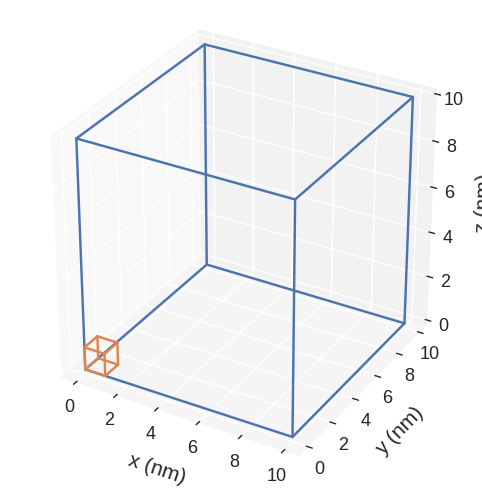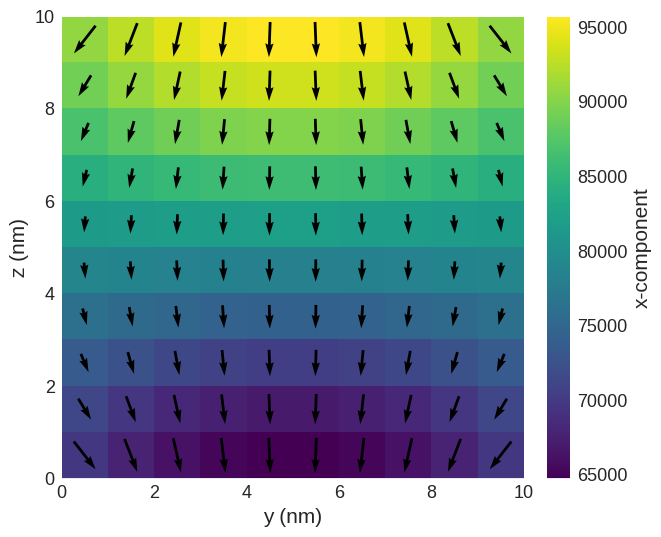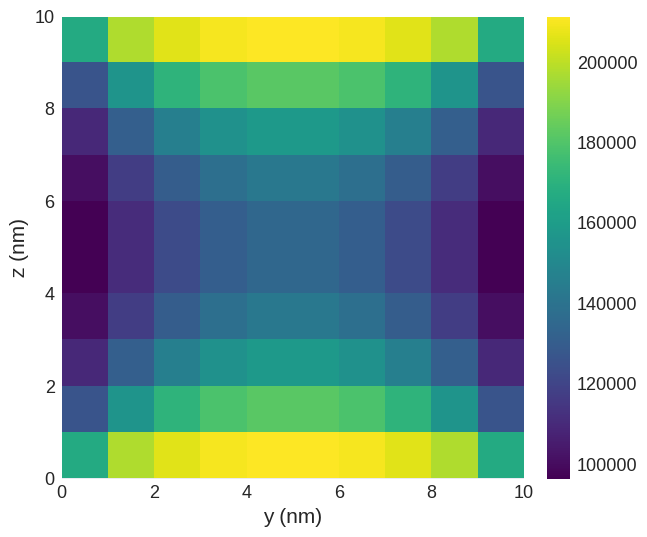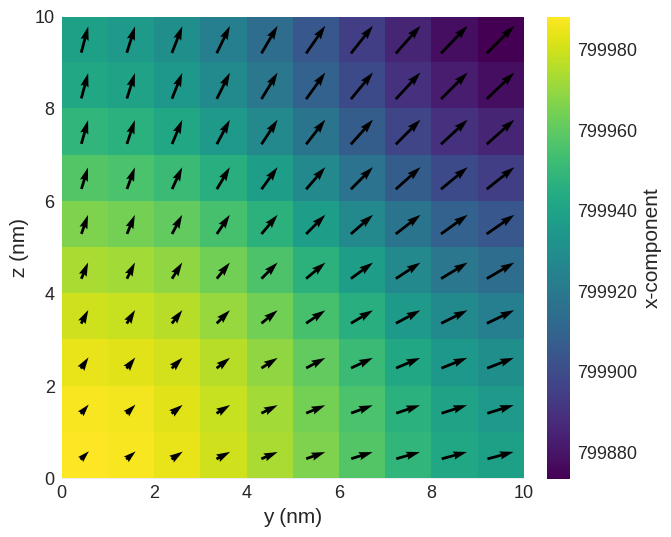Deriving energy values#
In this tutorial, we show how derived fields and values can be computed after the micromagnetic system is defined.
Simulation#
First of all, as usual, we import oommfc and discretisedfield.
[1]:
import oommfc as oc
import discretisedfield as df
import micromagneticmodel as mm
We define the cube mesh with edge length \(10 \,\text{nm}\) and cell discretisation edge \(1 \,\text{nm}\).
[2]:
mesh = df.Mesh(p1=(0, 0, 0), p2=(10e-9, 10e-9, 10e-9), cell=(1e-9, 1e-9, 1e-9))
mesh.mpl()

Now we define the system object and its Hamiltonian.
[3]:
system = mm.System(name="system")
A = 1e-11
H = (0.1 / mm.consts.mu0, 0, 0)
K = 1e3
u = (1, 1, 1)
system.energy = (
mm.Exchange(A=A) + mm.Demag() + mm.Zeeman(H=H) + mm.UniaxialAnisotropy(K=K, u=u)
)
system.energy
[3]:
We will now intialise the system in \((0, 0, 1)\) direction with \(M_\text{s} = 8\times 10^{5} \,\text{A/m}\) and relax the magnetisation.
[4]:
Ms = 8e5
system.m = df.Field(mesh, nvdim=3, value=(0, 0, 1), norm=Ms)
Effective field#
All computations are performed using oc.compute, where oc is the micromagnetic calculator we choose at import. compute function takes two arguments:
Property we want to compute
System object
Total effective field is:
[5]:
oc.compute(system.energy.effective_field, system).sel("x").mpl()
Running OOMMF (ExeOOMMFRunner)[2023/10/23 16:06]... (0.4 s)

Similarly, the individual exchange effective field is:
[6]:
Hex_eff = oc.compute(system.energy.exchange.effective_field, system)
Running OOMMF (ExeOOMMFRunner)[2023/10/23 16:06]... (0.2 s)
Because we initialised the system with the uniform state, we expect this effective field to be zero.
[7]:
Hex_eff.mean()
[7]:
array([0., 0., 0.])
The energy density is:
[8]:
w = oc.compute(system.energy.density, system)
w.sel("x").mpl()
Running OOMMF (ExeOOMMFRunner)[2023/10/23 16:06]... (0.2 s)

Similarly, the energy (volume integral of energy density) is:
[9]:
E = oc.compute(system.energy.energy, system)
print(f"The energy of the system is {E} J.")
Running OOMMF (ExeOOMMFRunner)[2023/10/23 16:06]... (0.2 s)
The energy of the system is 1.3470795322e-19 J.
Relax the system#
[10]:
md = oc.MinDriver()
md.drive(system)
Running OOMMF (ExeOOMMFRunner)[2023/10/23 16:06]... (0.4 s)
Compute the energy (and demonstrate that the energy decreased) and plot its magnetisation:
[11]:
E = oc.compute(system.energy.energy, system)
print("The system's energy is {} J.".format(E))
system.m.sel("x").mpl()
Running OOMMF (ExeOOMMFRunner)[2023/10/23 16:06]... (0.2 s)
The system's energy is 5.35285533145e-20 J.

Computing energies of individual term#
For instance, the exchange energy is:
[12]:
oc.compute(system.energy.exchange.energy, system)
Running OOMMF (ExeOOMMFRunner)[2023/10/23 16:06]... (0.4 s)
[12]:
1.12170191751e-21
We can also check the sum of all individual energy terms and check if it the same as the total energy.
[13]:
total_energy = 0
for term in system.energy:
total_energy += oc.compute(term.energy, system)
print("The sum of energy terms is {} J.".format(total_energy))
print("The system's energy is {} J.".format(oc.compute(system.energy.energy, system)))
Running OOMMF (ExeOOMMFRunner)[2023/10/23 16:06]... (0.3 s)
Running OOMMF (ExeOOMMFRunner)[2023/10/23 16:06]... (0.3 s)
Running OOMMF (ExeOOMMFRunner)[2023/10/23 16:06]... (0.2 s)
Running OOMMF (ExeOOMMFRunner)[2023/10/23 16:06]... (0.2 s)
The sum of energy terms is 5.352855331462e-20 J.
Running OOMMF (ExeOOMMFRunner)[2023/10/23 16:06]... (0.3 s)
The system's energy is 5.35285533145e-20 J.


